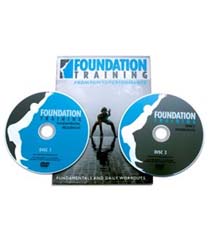Story at-a-glance
- An estimated 75-85 percent of Americans will experience back pain at some time in their life. Most cases are mechanical in nature, meaning the pain is not due to a serious medical condition such as inflammatory arthritis or fracture, instead the pain is a product of poor posture and improper movement.
- One of the latest drug scams is pushing an expensive anti-rheumatic drug for back pain. This drug can cost you $20,000 per year, yet most people’s back pain is NOT due to random inflammation, even inflammatory arthritis such as Rheumatism is controlled better through diet and exercise than with drugs. Shutting down your body’s natural inflammatory response is simply asking it to stop warning you of a larger problem that needs to be addressed.
- Our often seated lifestyle contributes to back pain more than any other isolated factor. Too much sitting without proper balancing exercises can also decrease your lifespan and the quality of your years..
- Daily Foundation Training Exercises are one of the best practices you can add to compensate for long hours spent sitting. These are powerful, simple whole body movements that help strengthen your complete core and activate the muscles designed to keep you in a powerful posture all day long. More than a dozen additional guidelines are included that can help you prevent and treat back pain, whether acute or chronic. The key thing to take home from this is that most back pain is manageable, and the reality is that more often than not we are accidentally hurting ourselves by using the wrong muscles to move, or masking pain with chemicals that stop us from addressing the actual problem.
Most Popular
You Might Also Like
Simple Prevention and Treatment Strategies for Back Pain
March 29, 2013 |9,432views | + Add to Favorites
Print
|
HLN's Susan Hendricks reports on how you can prevent some back pain.
This is a Flash-based video and may not be viewable on mobile devices.
This is a Flash-based video and may not be viewable on mobile devices.
Visit the Fitness Video Library
By Dr. Mercola
An estimated 75-85 percent of Americans will experience back pain at some time in their life, and most cases are mechanical in nature, meaning the pain is not due to a serious medical condition such as inflammatory arthritis or fracture.
Fifty percent of all working adults say they have back pain, and it's one of the most common reasons for missed work.
According to the American Chiropractic Association,1 Americans spend at least $50 billion annually on back pain treatments, and are often left feeling more confused about their problem.
Not surprisingly, back pain has become a major target for Big Pharma disease mongering.2 The latest example of this is the emergence of ads for ankylosing spondylitis, a chronic inflammatory disease of the axial skeleton, which includes the spine.
“Do you have back pain? Are you dismissing it as resulting from 'lifting too much' at the gym or 'bad posture'?” one radio ad asks. “You might have ankylosing spondylitis.”The drug advertised is Humira, which has a price tag of about $20,000 a year. It is reprehensible for drug companies to promote this expensive and dangerous drug for an exceedingly rare cause of low back pain, which likely is responsible for less than a tenth of a tenth of one percent of low back pain.
Side effects of the drug3 include tuberculosis, serious infections, increased risk of lymphoma and other cancers, hepatitis B infection in carriers of the virus, allergic reactions, nervous system problems, blood problems, heart failure, certain immune reactions including a lupus-like syndrome, liver problems, and new or worsening psoriasis — and that’s the short list! There are many more.
Considering the fact that most cases of low back pain are not caused by inflammatory conditions, you probably do not need this drug — although you may have no trouble receiving it should you ask your doctor for it...
Besides addictive and dangerous painkillers, pain injections also carry risks. Last year, nearly two dozen people receiving steroid injections for chronic back pain contracted meningitis. The outbreak was traced to a contaminated batch of injectable steroids.4
Since poor posture and/or improper movement is to blame for most cases of back pain, one of the best things you can do to prevent and manage back pain is to exercise regularly and keep your back and abdominal muscles strong.
Foundation Training is a simple response to this common back pain problem. The program is inexpensive and can be surprisingly helpful, as these exercises are designed to help you strengthen your entire core and move the way nature intended.
What’s Causing the Pain?
With the exception of blunt force injuries, low back pain is commonly caused and exacerbated by:
Poor posture Poor physical conditioning facilitated by inactivity Internal disease, such as kidney stones, infections, blood clots Obesity Psychological/emotional stress Osteoporosis (bone loss)
Back Pain is a Primary Reason Why the US has so Many Prescription Drug Addicts
Unfortunately, many simply end up taking pain killers and retiring to bed instead of increasing their activity once the back pain starts. Back pain is actually one of the primary reasons why so many American adults get addicted to pain killers. Addiction is a terrible side effect of these drugs, considering they do not actively change the issue causing the pain in the first place.
Pharmaceutical drug overdoses now rank second only to motor vehicle crashes as the leading cause of accidental death in the US. The number of overdose deaths from opioid painkillers alone more than tripled from 1999 to 2006, to 13,800 deaths that year. This despite the fact that the FDA increased the restrictions for consumer drug ads in 2005, especially for COX-2 painkillers like Celebrex and Bextra.
In the past, most overdoses were due to illegal narcotics, such as heroin. But prescription painkillers have now surpassed both heroin and cocaine as the leading cause of fatal overdoses. In addition, more than 700,000 people visit US emergency rooms each year as a result of adverse drug reactions to all drugs, not just the opioids.
Adverse drug reactions from drugs that are properly prescribed and properly administered also kill about 106,000 people per year, making prescription drugs the fourth-leading cause of death in the US.
Pharmaceutical drugs kill more than twice as many Americans as HIV/AIDS or suicide, yet they’re still allowed to be advertised on TV, radio and in magazines. This is particularly ironic when you consider that the death toll from illegal drugs – which is about 10,000 per year – is dwarfed by the death toll (106,000 or more) from properly administered pharmaceuticals!
The first step toward meaningful change is realizing that prescription drugs are JUST as addictive and dangerous as illegal street drugs. In many cases, they are identical. The only difference is their legal status. For example, hydrocodone, a prescription opiate, is synthetic heroin – indistinguishable from any other heroine as far as your brain and body are concerned. So, if you’re hooked on hydrocodone, your body is responding as if you’re a heroin addict...
Perhaps even more ironic, prescription drug addiction is now also being advertised as a “medical condition” for which there is treatment... Back in the day, this was simply called Drug Rehab, but now they’re trying to remove the stigma associated with drug addiction, since the vast majority are hooked on legal meds. Just because the drugs are legal, does not mean the addiction is any less severe or damaging.
Tools to Prevent and Treat Back Pain
I strongly recommend considering the least invasive avenues before resorting to pain medication or surgery. For starters, many people fail to realize that many times back pain actually originates from tension and imbalance at a completely different place than where the pain is felt.
For example, the very act of sitting for long periods of time ends up shortening the Iliacus, Psoas and Quadratus Lumborum muscles that connect from your lumbar region to the top of your femur and pelvis. When these muscles are chronically short, it can cause severe pain when you stand up as they will effectively pull your lower back (lumbar) forward. The reality is that the imbalance among the anterior and posterior chains of muscles leads to many of the physical pains you may experience daily. By bringing these muscles to a better balance, you will consistently remedy many of these pains and discomforts.
Many people end up going through drastic medical procedures to "fix" this type of pain, or end up taking pain killers for extended periods of time. Seeing a qualified chiropractor is certainly a wise consideration if you suffer from back pain. I am an avid believer in the chiropractic philosophy, which places a strong emphasis on your body's innate healing ability and far less reliance on band-aid responses like drugs and surgery.
Foundation Training—an innovative method developed by Dr. Eric Goodman to treat his own chronic low back pain—is an excellent alternative to the Band Aid responses so many are given. Foundation Training exercises work to gradually pull your body out of the movement patterns that are hurting you.. The focus is on strengthening your complete core, which includes anything that directly connects to your pelvis, whether above or below it. Foundation Training teaches all those muscles to work together through integrated chains of movement, which is how your body is structurally designed to move. Every muscle that directly connects to your pelvis should be considered a piece of your core and this includes your glutes, adductors (inner thigh muscles), deep lower back muscles, hip flexors, hamstrings and all of your abdominal muscles.
Having strong, balanced core muscles is like having a built-in corset that not only holds your gut in, but also stabilizes your spine, vertebrae, discs, and most importantly your pelvis. Teaching your body to naturally support itself at the deepest level is going to be far more effective than strapping on an external back brace, which over time can lead to even weaker musculature. Foundation Training is like Olympic weight lifting for the deep postural muscles of the human body.
Yet another type of exercise called Egoscue can also be helpful in mitigating the damage from excess sitting. And, if you’re in pain, Neuro-structural integration technique (NST) is another non-drug pain relief option. NST is a gentle, non-invasive technique that stimulates your body's reflexes. Simple movements are done across muscles, nerves and connective tissue, which helps your neuromuscular system to reset all related tension levels, promoting natural healing. It is completely safe and appropriate for everyone from highly trained athletes, to newborns, pregnant women, and the elderly and infirm. To find an NST therapist near you, see our NST Therapists Page. You can also purchase a DVD set to learn more about this technique.
Foundation Training Basics
I’m a huge fan of Foundation Training, and the primary exercise, called The Founder, is one that everyone would be wise to learn. It’s an integrated movement that pulls together your entire posterior chain of muscles, thereby strengthening your back while lengthening your front. This and all other Foundation Training exercises disperse the force throughout your body and takes friction away from your joints, placing that tension into your muscles instead.
I do these exercises daily and it is a great tool to build a stronger and more stable low back that is free from pain. Foundation Training can help counteract the negative effects of excessive sitting, which is not only a cause of chronic back pain, but can also increase your mortality risk from all causes.
When you sit, your head and shoulders drop forward, and your hip flexors and abdomen shorten. Every exercise included in Foundation Training lengthens the front of your body, which is over-tightened, and strengthens the back of your body, which will help you stand tall and move with strength and flexibility. As explained by Dr. Goodman:
“The place to start is learning how to hinge effectively. Learning how your hamstrings, lower back, and glutes are designed to stretch together. Once that part is in place, you can then advance to all the exercises that build upon that foundation, that build upon The Founder exercise.”
Structural Decompression Breathing Also Helps Improve Posture and Reduce Pain
Breathing is another important tool that is unfortunately ignored by most people. In his TED Talk below, Dr. Goodman demonstrates structural breathing, which will help improve your posture, especially while seated. Here’s a summary:
When done properly, your breath will help lengthen your hip flexors, stabilize your spine, and support your core using your transverse abdominal muscles. This will strengthen your back and keep your chest high and open. Do this exercise for 30 seconds or so, then go back to your normal seated position. With time, those muscles will get stronger, and your seated posture will gradually improve. With Foundation Training you should quickly notice dramatic improvement to your daily posture.
- Sitting down or standing, place your thumbs at the base of your rib cage, pinkies at pointy bones at the front of your waist. Think of the space between your fingers as a measuring stick.
- Pull your chin back so that your chest is lifting upwards and take three slow deep breaths as I instruct you below.
- As you breathe in, the distance between your thumbs and pinkies should increase.
- As you breathe out, tighten your abdominal muscles to prevent your torso from collapsing back down. This is the important step, do not let your torso drop back down towards the pelvis as you exhale. It should be challenging and you should feel your abdomen engage as you exhale.
The basic Foundation Training program takes about 20 minutes, and is ideally done daily. You can purchase the Foundation Training DVD from my online store. FoundationTraining.com also offers several free videos , and their thought provoking first book called: Foundation: Redefine Your Core, Conquer Back Pain, and Move with Confidence.
Even More Tips to Beat Back Pain
Preventing back pain is surely easier than treating it. Besides the recommendations already covered above, which included getting chiropractic adjustments, Foundation Training, Egoscue exercises, and NST, below are several more tips for beating back pain. With this many alternatives available, there are few good reasons to turn to pharmaceutical or surgical band-aids that do nothing to treat the underlying causes of your pain, and might cause additional harm in the process:
- Exercise and physical activity will help strengthen the muscles of your spine. Make your exercise time count by including high-intensity sessions. You probably only need this once or twice a week at the most. You'll also want to include exercises that really challenge your body intensely along with those that promote muscle strength, balance and flexibility. Remember to build up your entire core to avoid back pain. Always do some stretching and warm-ups before engaging in strenuous physical activity, and make sure you focus on strong, balanced posture.
- Optimize your vitamin D and K2 levels to prevent the softening of the bones that can often lead to lower back pain.
- If you spend many hours every day in a chair like I do pay careful attention to consciously sucking in your belly and rotating your pelvis slightly up. At the same time make sure your head is back with your ears over your shoulders and your shoulder blades pinched. This will help keep your spine in proper alignment. You can hold these muscles tight for several minutes and do this every hour you are sitting.
- Address psychological factors. Few people want to be told that their pain is psychological or emotional in origin, but there's quite a bit of evidence that backs this up. Underlying emotional issues and unresolved trauma can have a massive influence on your health, particularly as it relates to physical pain. Dr. John Sarno,5 for example, used mind-body techniques to treat patients with severe low back pain and has authored a number of books on this topic. His specialty was those who have already had surgery for low back pain and did not get any relief. This is one tough group of patients, yet he had a greater than 80 percent success rate using techniques like the Emotional Freedom Technique (he has now retired from practice).
- Get regular massage therapy. Massage releases endorphins, which help induce relaxation and relieve pain.
- Keep your weight spread evenly on your feet when standing. Don’t slouch when standing or sitting to avoid putting stress on your back muscles.
- Always support your back, and avoid bending over awkwardly. Protect your back while lifting – this activity, along with carrying, puts the most stress on your back.
- Sleep in a firm bed. Sleeping on your side to reduce curving of your spine and stretching before getting out of bed is also helpful.
- Use chairs or car seats that offer good lumbar support. Switch positions often while sitting, walk around a bit and do some light stretching to relieve tension.
- Wear comfortable shoes. For the ladies, it would be good to not wear heels most of the time.
- Drink plenty of water to enhance the height of your intervertebral disks. And because your body is composed mostly of water, keeping yourself hydrated will keep you fluid and reduce stiffness.
- Quit smoking as it reduces blood flow to your lower spine and your spinal disks to degenerate.





No comments:
Post a Comment